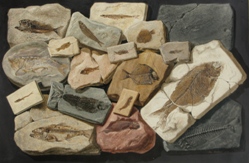It’s a year since the library launched its ‘Sponsor a fish’ appeal, and the results are - forgive us – off the scale. Michael McKimm reports.
Geoscientist 22.06 July 2012

The Library and Archive wishes to thank all those who have donated to the appeal to conserve and digitise nearly 2000 drawings from the fossil fish collection of Louis Agassiz (1807–1873). Through the generosity of Fellows, Friends and members of the public from around the world we have raised over £6000, a brilliant achievement for the first year of the appeal and one we hope to build on in the year to come.
Many fish were sponsored in memory of friends or relatives who had a particular interest in fossil ichthyology, while other donations were made as birthday, retirement and even wedding gifts (on such occasions a certificate is provided). We still have some way to go, however, as £20,000 is required to clean, conserve and digitise all of the drawings fully, so making them available to new groups of researchers for generations to come. If you would like to sponsor a fish for £20, please send a cheque to the Library, or call 020 7432 0999 to pay by card. Larger donations are greatly welcomed.
Fundraising, one could argue, has a fossil history all its own – Agassiz himself was no stranger to it. For it was through the benefaction of many notable figures that the scientist, arriving in Neuchatel, Switzerland at the age of 25, was able to begin work on what would be his seminal opus, Recherches sur les poissons fossiles. In it he would ‘present Fishes through nearly all the geological ages, almost from the beginning of life’2. The magnitude of Agassiz’s plans were daunting, but with financial assistance from the King of Prussia, the Earl of Enniskillen, Sir Francis Egerton, friends and family, as well as the Geological Society, he created a lithographic establishment in Neuchatel where he could keep ‘draughtsmen of superior talent, trained by himself to the greatest accuracy’ in permanent employ2.
These artists, including J C Weber, Joseph Dinkel and Auguste Sonrel, drew the vivid and detailed watercolours which we now seek to conserve and digitise. Using the relatively new technique of lithography – where the mutual repulsion of oil and water on a slab of limestone creates an image to be printed – the drawings were reproduced to form the Atlas of nearly 400 plates that would accompany Agassiz’s important five-volume book.
Lithographic Prints for Sale
We are now giving you a rare opportunity to purchase one of the original lithographic prints from a copy of Agassiz’s Recherches sur les poissons fossiles, which have been kindly offered by a Fellow of the Society to raise funds for the appeal. Please bear in mind that these are original lithographs from circa 1840 and show some natural wear and tear due to their age. Why not view them online now at www.geolsoc.org.uk/sponsorafish and become the proud owner of a slice of fossil fish history?
References
- Guyot, Arnold Memoir of Louis Agassiz, 1807-1873 Read before the National Academy, April, 1878
- Ibid.